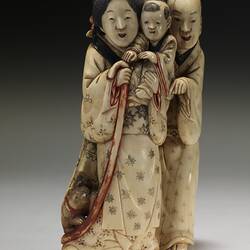Summary
Imari double-gourd vase, manufactured in Japan, probably during the early Meiji Period (1868-1880).
Imari porcelain ware takes it name from the port-city of Imari in the Saga Prefecture on the southern island of Kyushu, Japan. From the late seventeenth century, Imari porcelain was extensively exported specifically for the European market. In Japan, this type of porcelain is also referred to as Arita-yaki, as much of it is made in the town of Arita in the Saga Prefecture.
Like many examples of Japanese porcelain, the vase base is marked with a blue 'fuku' mark, representing good fortunate and happiness. The vase is decorated in the akaji-kinrande style of iron red overglazing with foliate motifs and design in gold and other colours. The style has its origins in Chinese Ming-period (1522-66) porcelain ware, and in Japan this style of decoration was known as Kinrande. In the late Edo period (1603-1867) in Japan, many of the kilns that produced Imari ware, and other porcelain products such as Kutani or Kyo-yaki ware, decorated them in the Kinrande style.
The Japanese firm Koransha exhibited Imari ware at the 1880 Melbourne International Exhibition. The Koransha Factories were established at Arita in 1875 by Eizaemon Fukagawa, of the well-established Fukagawa family of ceramists, for the purpose of producing porcelain ware for the Western export market. The company subsequently won a certificate of merit at the Philadelphia Centennial Exposition in 1876, and a gold prize at the 1878 Paris Universelle Exposition. They exhibited Arita porcelain bowls, flower-vases - such as this one - and tea sets in Melbourne in 1880.
Physical Description
Double gourd form vase, with short cylindrical neck. White body, painted dark red. Painted all over with gold tendrils, and pink and blue chrysanthemum. Two panels on lower bulb painted on opposite sides with scenes of bonsai, two smaller panels painted with bowls of flowers.
More Information
-
Collection Names
-
Collecting Areas
-
Acquisition Information
Cultural Gifts Donation from Dr Will Twycross, 23 Jan 2009
-
Acknowledgement
Donated through the Australian Government's Cultural Gifts Program
-
Place & Date Manufactured
-
Exhibitor
Koransha, Melbourne, Greater Melbourne, Victoria, Australia, 1880
-
Place & Date Exhibited
Royal Exhibition Building (REB), Carlton, Greater Melbourne, Victoria, Australia, 1880-1881
-
Collector
Mr John Twycross, Elsternwick, Greater Melbourne, Victoria, Australia, 1880-1881
-
Inscriptions
Kanji of 'fuku' (good fortune) printed on underside in blue.
-
Classification
Royal exhibition building, International exhibitions, Exhibition heritage
-
Category
-
Discipline
-
Type of item
-
Overall Dimensions
135 mm (Width), 195 mm (Height)
-
References
Moyra Clare Pollard, 'Master potter of Meiji Japan: Makuzu Kôzan (1842-1916) and his workshop', OUP, 2002.
-
Keywords
Ceramics, Decorative Arts, Exhibitions: Melbourne International, 1880-1881, Japanese Art, Royal Exhibition Building



